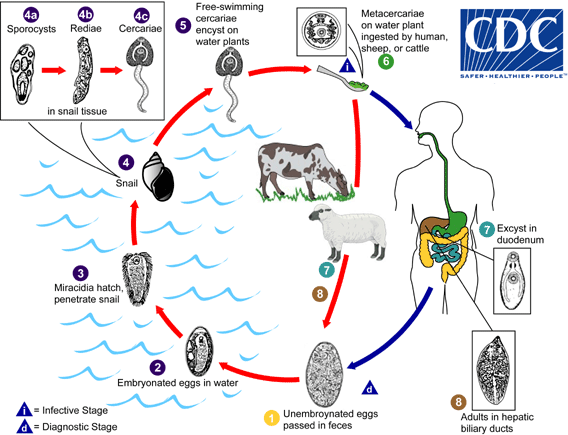Datei:Fasciola LifeCycle.gif
Fasciola_LifeCycle.gif (568 × 435 Pixel, Dateigröße: 58 KB, MIME-Typ: image/gif)
Dateiversionen
Klicke auf einen Zeitpunkt, um diese Version zu laden.
| Version vom | Vorschaubild | Maße | Benutzer | Kommentar | |
|---|---|---|---|---|---|
| aktuell | 21:05, 9. Jul. 2015 |  | 568 × 435 (58 KB) | CFCF | updated |
| 18:59, 10. Mai 2006 |  | 568 × 435 (45 KB) | Patho | {{Information| |Description=Causal Agents: The trematodes Fasciola hepatica (the sheep liver fluke) and Fasciola gigantica, parasites of herbivores that can infect humans accidentally. Life Cycle: Life cycle of Fasciola hepatica Immature eggs are disch |
Dateiverwendung
Die folgenden 4 Seiten verwenden diese Datei:
Globale Dateiverwendung
Die nachfolgenden anderen Wikis verwenden diese Datei:
- Verwendung auf ca.wikipedia.org
- Verwendung auf ceb.wikipedia.org
- Verwendung auf cs.wikipedia.org
- Verwendung auf es.wikipedia.org
- Verwendung auf fr.wiktionary.org
- Verwendung auf gl.wikipedia.org
- Verwendung auf gl.wiktionary.org
- Verwendung auf hi.wikipedia.org
- Verwendung auf it.wikipedia.org
- Verwendung auf kk.wikipedia.org
- Verwendung auf ru.wikipedia.org
- Verwendung auf se.wikimedia.org
- Verwendung auf sv.wikipedia.org
- Verwendung auf vi.wikipedia.org
- Verwendung auf vi.wiktionary.org

